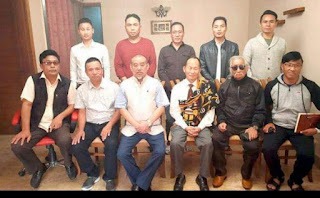Was the so-called ‘Gujral doctrine’ only a humbug?
Could a suave and ‘expert hand’ in foreign policy — famous for his ‘Gujral doctrine’ — I K Gujral commit such a lapse ? Or all these were oversights? It was the time when Lalu Prasad was to be jailed, maybe Prime Minister I K Gujral — who once was almost a Lalu Prasad protege — was busy otherwise.
On the other hand, Communists in India either commit historical blunders or regret later that some of their critical decisions have been ‘historical blunders’.
Denying seasoned Marxist Jyoti Basu Prime Minister ship was one such decision.
The roles by communists in 1962 were both critical and messy. Even Emergency records do not
inspire much confidence. Prakash Karat lamented after the over ambitious Marxist Somnath Chatterjee declined to resign as Lok Sabha Speaker in 2008.
In 2021, they indirectly helped Mamata Banerjee and could not win even a single seat in West Bengal assembly.
Now in circa 2022 – after they have disappeared from West Bengal legislative assembly and lost power
in Tripura and Kerala being the only saving grace, it is others who are finding fault with the country’s only communist Home Minister Indrajit Gupta.
Paradoxically, it is in the most unexpected quarter. Well, along with comrade Indrajit Da (Gupta), two Prime Ministers I K Gujral and H D Deve Gowda are also getting their share of the blame.
While one talks of the Naga peace parleys having started under two United Front Prime Ministers H D Deve Gowda and I K Gujral, we tend to forget that under both PMs, comrade Indrajit Gupta was the Home Minister.
During the tenure of Atal Bihari Vajpayee as his Home Minister, L K Advani was stunned to note that Gujral never met the NSCN-IM leaders but announced a ceasefire in August 1997.
Of course, his predecessor H.D. Deve Gowda had met NSCN-IM leaders Late Isak Chishi Swu and Thuingaleng Muivah in February 1997 in Zurich.
But the ceasefire initially only for six months was announced between NSCN-IM and the government in July-August 1997 when Gujral was the Prime Minister.
The announcement made on July 25, 1997 in the Parliament came into effect from August 1.
Gujral even admitted certain things were ‘secret’ and certain things were not discussed with the militant group. The army operations were at peak against the ultras in Manipur and Nagaland and the group had suffered heavy casualties too by 1996-97.
The Nagaland peace talks are at crossroads now and according to some in a mess after ‘green carpet’ treatment given to NSCN-IM leaders in Delhi providing them with an official house and security — all at taxpayer’s money.
In 1998-99, when the Vajpayee government was in power, senior officials used to often say that one big demerit of the 1997 Naga ceasefire was that it “lacked clear definition”.
One senior official had said: “There were no written terms and conditions and it was merely an understanding.”
Today, that confusion has actually opened a Pandora’s Box. The NSCN-IM militants are negotiating for peace and at the same time, they want a separate flag and a Naga Constitution.
On October 17, 2020, former Mizoram Governor Swaraj Kaushal had said, “The symbols of sovereignty namely, separate constitution, flag, currency, defence and foreign affairs are sacrosanct and never negotiable.”
Kaushal was the first official interlocutor in Naga peace matters around 1998 when Vajpayee became the Prime Minister for the second term.
Gujral never met NSCN-IM leaders but announced the ceasefire in July 1997 to be effective from August 1, 1997.
Both PMs – Deve Gowda and Gujral must have got their hands in so many other challenges and hence the Naga peace talks were left to the Home Ministry and some senior officials.
As the in-charge of the Home Ministry (MHA), in retrospect, it is being argued today that Indrajit Gupta should have done his part well.
When members in the Parliament and outside it sought ‘more details’ on the ceasefire from Prime Minister Gujral, they were requested not to press for it.
Even the so-called Competencies to the Framework Agreement inked in 2015 have been kept under the carpet.
As a result of this, even the Core Committee of Nagaland MLAs and ministers and elected Chief Minister Neiphiu Rio are not aware of the details of the parleys between NSCN-IM and the Centre even today.
Sources close to Chief Minister Rio said, “Yes, the Chief Minister does not have the details. These have made things difficult at times.”
Naga intellectuals and even voluntary organisations are annoyed over this ‘lack of transparency’.
“Our stand and deal is open and transparent… The status paper is clear,” said NNPG convener N. Kitovi Zhimomi.
This umbrella organisation is not insisting on the flag and a separate Naga Constitution, saying all such issues can be discussed later as what is of paramount importance now is peace and an early solution.

















Comments